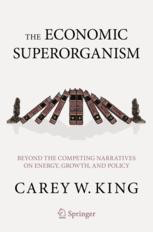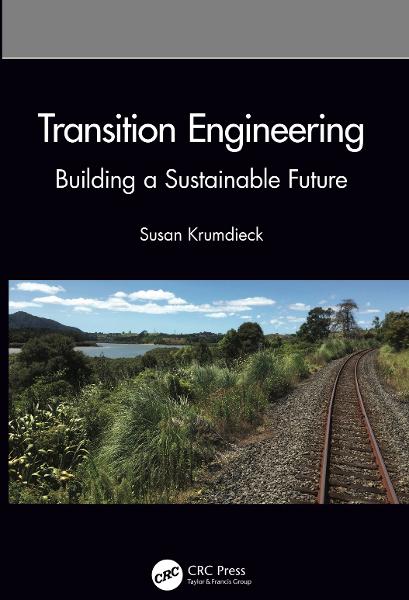Transition Engineering Building a Sustainable Future
by Susan Krumdieck
Transition Engineering: Building a Sustainable Future examines new strategies emerging in response to the mega-issues of global climate change, decline in world oil supply, scarcity of key industrial minerals, and local environmental constraints. These issues pose challenges for organisations, businesses, and communities, and engineers will need to begin developing ideas and projects to implement the transition of engineered systems. This work presents a methodology for shifting away from unsustainable activities. Teaching the Transition Engineering approach and methodology is the focus of the text, and the concept is presented in a way that engineers can begin applying it in their work.
NEW! The University of Canterbury in New Zealand has sponsored the book as Open Access!
Table of Contents
Introduction - What is the role of engineers in changing the future?
Chapter 1 - The Mega-Issues of Unsustainability
Accumulation of Greenhouse Gas, Fossil Fuel Supply, but particularly the problem of Peak Oil. The Monkey Trap
Chapter 2 - Problems of Unsustainability
Sustainability Principles, Carrying Capacity, Resource Constraints, Population, Water, Lifestyle Expectations - but mostly the problem of Exponential Growth. Bacteria in the Jar
Chapter 3 - Complexity and Communication
Numerization is the key to cutting through the emotion and nonsense. Finding good data and making straightforward investigations. Presenting data in graphs and figures. The Fox and the Hedgehog and the Bigger Picture
Chapter 4 - Transition Engineering
The Interdisciplinary Transition Innovation, Management and Engineering methodology and how to use it for wicked problems. Blind Men and the Elephant
Chapter 5 - InTIME Models and Methods
Theory of Anthropogenic System Dynamics, Development Vector, Strategic Analysis of Complex Systems, The Matrix Game
Chapter 6 - Economic Decision Support
Cost of Energy, Environmental Externalities and Health Effects. Standard economic analysis. Emperor's New Clothes
Chapter 7 - Transition Economics: Balancing Costs and Benefits
Energy Return on Energy Invested (EROI) and other ways to look at the future. Low-Hanging Fruit
Chapter 8 - Conclusion and Discussion
Cassandra and the Big DO
Video Introduction
Reviews
Here is a book that captures the essential energy crisis of dependency on fossil fuels at a time when dramatic change is urgently needed to reduce emissions of greenhouse gases to avert the worst effects of climate instability. The book is accessible in style and uses imagery that illustrates the problems faced and the solutions available. Engineers need to increase their understanding of the huge challenges around energy that society faces, and this book helps with this understanding."
Peter Guthrie, Professor- Engineering for Sustainable Development, Cambridge University, UK
"Usually, the societal transition from fossil fuels to renewable energy is discussed in terms of politics and investment. However, this historic shift also presents a huge and fascinating engineering challenge. Transition Engineering is a clear and useful guide to understanding technological issues in key aspects of energy production and usage, as they relate to a sustainable future. If you are interested in making a practical contribution to fighting climate change by redesigning industrial systems, you owe it to yourself to read this book."
Richard Heinberg, Post Carbon Institute, USA
"If you want to be challenged in the way that you think about the future role of energy in an economy that seriously tries to address the problems of finite resource depletion and climate change, then expose yourself to this book’s provocative ideas on how engineering analysis can lead the way. It gets engineers to think as they are trained and inspires non-engineers to change their viewpoint and take action."
Carey King, Mechanical Engineering, University of Texas at Austin
Transition Engineering is a refreshing entry into the many books dealing with the existential issues of climate change and sustainability. Because Susan is an engineer she focuses on what is practical and what is possible, cutting through the noise of unrealistic or impractical solutions so we can focus on what will work and get down to the business of addressing climate change and building a sustainable future.
Matt Orsagh, CFA – Senior Director, Capital Markets Policy at CFA Institute
Professor Susan Krumdieck’s book Transition Engineering: Building a Sustainable Future is a technical instructional manual for engineers faced with how to adapt within our cities to meet the targets of 80 percent less fossil fuel. Not just the technical stuff, it’s also a strong imperative to do what we clearly must, to effect the inevitable downshift in energy use and in how we operate in the world.
Pat Basket, Climate Activist, New Zealand
A Bold New Approach to the Climate Crisis
There is a growing consensus that urgent action is needed to prevent mass displacement of populations and ecosystem collapse. But what exactly do we need to DO? How will we do it? Who is “we”? Dr Krumdieck’s book, "Transition Engineering: Building a Sustainable Future", provides the missing piece of the puzzle: the operations manual for the carbon downshift.
IMechE, Editorial
This book is an essential read for anyone who is remotely serious about how we get out of the mess we are in. Please read the review and then read the book! The book is an outstanding resource for those of us working “where the rubber hits the road” on decarbonisation. My copy is, I am afraid to confess, filled with pencil annotations and bent over page corners! In some ways it is good that I have taken two years to get around to writing this review as I can better share the value of the book.
Naill Enright, Consultant
Transition engineering is a proactive imperative that demands seeing the problem clearly. Engineers are good at fixing problems, but not necessarily good at picking the right problem to fix. Our challenge is that in developing a cleaner economy, we must also reduce its metabolism to adapt to energy decline. As Professor Krumdieck puts it, let’s not increase our risks by rushing more sustainably toward catastrophic unsustainability. This is a book for engineers, young and old, and others who want a user’s manual for repairing global wicked problems. If you’ve read the IPCC reports, and are wondering what on Earth to do next, read Transition Engineering: Building a Sustainable Future.
Jennifer Wilkins, 2022, Founder and developer of business sustainability knowledge platform Heliocene.org
The underlying approach to Transition Engineering makes sense. Step-down projects consider the site specific conditions at a defined location and focus on essential activities, although projects may have applicability to other locations and other activities. There are no simple solutions that can be applied universally, but the approaches outlined in the book for evaluating the status quo vs. change projects allows for a more comprehensive analysis and evaluation of the alternatives. I struggled with trying to figure out how dams and the benefits they provide fit into Transition Engineering projects but concluded that there are considerations for water projects. The needs and activities supported by water projects (municipal, agricultural and industrial water supply; flood control; and hydroelectric power) are critical in many locations and could be impacted by changes in communities resulting from transition projects, such as higher density housing in urban areas and development of urban agriculture. Hydrologic power has one of the highest EROI values and maintaining these resources can be a major part of the solution in many areas.
The challenges presented by the wicked problem of unsustainable energy use are daunting, but I agree with premise of the book that engineers are in the best position to identify the solutions and implement the change. The last sentence of the book presents the best direction for engineers:
Now get busy preventing what is preventable.
Bill Fiedler, 2022, Geotechnical Civil Engineer, Retired, US Army Corps of Engineers
Apart from the growing sense of impending doom one gets when reading about quite how deep in the doo we are, I enjoyed reading this book. It doesn't read like an "Engineering" text and should be of real interest to any environmental scientist concerned about climate change and our addiction to fossil fuels. This book also offers solutions, a way of thinking about problems that incorporates scientific, economic and social factors. It doesn't suggest the solutions are easy though.
Magnus Johnson, 2023, University of Hull, UK
This book is going to be the most important textbook used in the leading schools that teach the Transition Engineering GCSE/IB. We need 1 million Transition Engineers! These will be the most sought after and highly skilled consultants: hired by Governments, Regions, Councils, Municipalities, Industries, Businesses, and even individuals.
Amazon Review, 2021, UK
Susan's book is a great engineering tool to cut through the greenwashing, politicking, and bias of carbon reduction options. This takes us back to the basics of understanding the heat and material balance; the potential risks / unintended consequences of the actions; and cost / benefit analysis.
I would put Susan's tools for evaluating sustainability on a par with Trevor Kletz ideas for safety.
This should be a prerequisite for any engineering student working towards their BS / BSc in engineering. If you are going into Chemical Engineering, Civil Engineering, Petroleum Engineering, Industrial Engineering, or Engineering / Sciences associated with the construction or engineering sectors; this really should be a fundamental part of your education.
Amazon Review, 2022, USA
Bookshelf for Reference Books and Textbooks
 Chapter 13 Transition Engineering (2014)
Chapter 13 Transition Engineering (2014) Transition Engineering pp 647-706 (2017)
Transition Engineering pp 647-706 (2017) Chapter 34 Transitioning to Sustainable Engineering Systems (2022)
Chapter 34 Transitioning to Sustainable Engineering Systems (2022) Chapter 2 Survival is the Driver for Adaptation (2022)
Chapter 2 Survival is the Driver for Adaptation (2022)

Great reads for context, contemplation and deep thinking:
The Ingenuity Gap
Thomas Homer-Dixon (2000), Knopf. The book gives interesting background on problem solving and ingenuity. It argues that the complexity and systems nature of problems is growing exponentially, while the ability to approach and solve the problems we are creating is failing to keep up. The book does not give any suggestions about what to do, but it does make a great case for Transition Engineering!
More is Less: How DeGrowth will save the world
Jason Hickel (2021), Penguin. The book gives a well researched historical study of capitalism and growth which Transition Engineers can find useful. The evidence unpicks the assumption that growth has been responsible for improvement of wellbeing and standard of living. Growth is responsible for wealth accumulation, and public investment in wellbeing is responsible for wellbeing. That is an interesting argument. It fits very well with the anthropogenic system dynamics theory. The prescription for degrowth does not recognise the essential role of engineering in delivering the downshift designs and projects. But it does set up the excellent case for Transition Engineering.
Donut Economics: Seven ways to think like a 21st-Century economist
Kate Raworth (2017) Random House. For non-economists, the first part of the book gives an honest and challenging history of the academic field of economics and how it has influenced political and corporate largesse. This is an important resource for Transition Engineering. The seven ways set out to think about the way different efforts and activities are valued fits very well with the InTIME Design approach.
How to Blow Up a Pipeline
Andreas Malm (2021) Verso Books. We don't find that many activists among professional engineers. That is just an observation. This book delves into the world of activism and in particular makes an articulate argument for the concept we use in Transition Engineering - unsustainability is unacceptable. if some institution is unacceptable, and let's be clear, unsustainability is an institution of the capitalist growth economy, then there will be a movement that will rise to the challenge and will not rest until the institution has been reformed. If nothing else, Transition Engineering can use this argument as the social license to undertake the work of preventing what is preventable.

